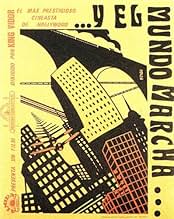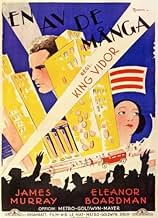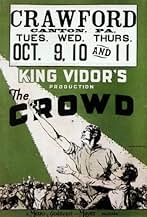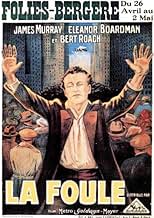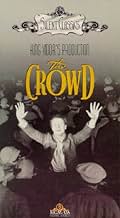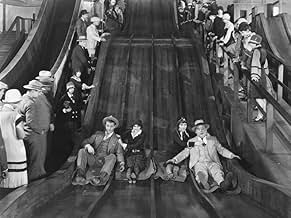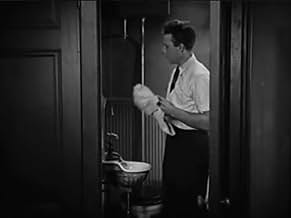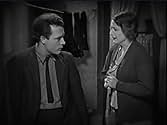VALUTAZIONE IMDb
8,0/10
9766
LA TUA VALUTAZIONE
Aggiungi una trama nella tua linguaThe life of a man and woman together in a large, impersonal metropolis through their hopes, struggles, and downfalls.The life of a man and woman together in a large, impersonal metropolis through their hopes, struggles, and downfalls.The life of a man and woman together in a large, impersonal metropolis through their hopes, struggles, and downfalls.
- Regia
- Sceneggiatura
- Star
- Candidato a 2 Oscar
- 4 vittorie e 2 candidature totali
John D. Bloss
- Boy on Fence
- (non citato nei titoli originali)
Roy Bloss
- Boy on Fence
- (non citato nei titoli originali)
Sidney Bracey
- John's Supervisor
- (non citato nei titoli originali)
Johnny Downs
- John - Age 12
- (non citato nei titoli originali)
Sally Eilers
- Party Girl at Bert's Place
- (non citato nei titoli originali)
Joseph W. Girard
- Member of Board of Directors
- (non citato nei titoli originali)
Pat Harmon
- Truck Driver
- (non citato nei titoli originali)
Chris-Pin Martin
- Worker in Hallway
- (non citato nei titoli originali)
Claude Payton
- Undetermined Secondary Role
- (non citato nei titoli originali)
Recensioni in evidenza
The most remarkable thing about 'The Crowd (1928)' is that is manages to cover so much emotional ground. John (James Murray) is a young man who knew from an early age that he would become somebody special, that he would stand out from the crowd. At age 21, he travels to New York, the towering metropolis introduced via a montage of impressive high- angled shots that resemble Robert Florey's 'Skyscraper Symphony (1929).' John joins the accounting sector of a large insurance firm, and studiously assures himself that he need only work his way up. Years pass. John marries, has two children. It takes him five years to realise that he has become what he swore never to become: a member of The Crowd.
Vidor's message is a double-edged sword. Early in the film, The Crowd is something to be loathed: the camera, in a virtuoso display of technical brilliance, swoops down upon a seemingly-endless room of seated accountants, each man turning pages in mechanical unison. (Billy Wilder later paid homage to this scene in 'The Apartment (1960)'). But when John finally determines to break free from The Crowd, his world falls apart around him – he can't maintain a job, his wife threatens to leave him, he loses his dignity. The film's ending is intriguing in its ambiguity: John is absorbed into the crowds of a laughing theatre audience.
Is it a happy ending, an embracing of conformity? Is it ironic, an acknowledgment of mass delusion? Is Vidor integrating his character into the cinema audience? In 'The Bicycle Thief (1948),' a similar disappearance into the crowd is viewed as tragic, but here I'm not so sure. F.W. Murnau's 'The Last Laugh (1924)' told a similar tale, depicting the bleak prospects of a working-class doorman, played by Emil Jannings. UFA studio thwarted that film by enforcing a ludicrous happy ending that Murnau included only with a snide introductory title card. M-G-M also toyed with a happy ending to 'The Crowd,' but fortunately Vidor's version ultimately won out, a conclusion genuinely unsettling in its uncertainty, and sure to inspire discussion.
Vidor's message is a double-edged sword. Early in the film, The Crowd is something to be loathed: the camera, in a virtuoso display of technical brilliance, swoops down upon a seemingly-endless room of seated accountants, each man turning pages in mechanical unison. (Billy Wilder later paid homage to this scene in 'The Apartment (1960)'). But when John finally determines to break free from The Crowd, his world falls apart around him – he can't maintain a job, his wife threatens to leave him, he loses his dignity. The film's ending is intriguing in its ambiguity: John is absorbed into the crowds of a laughing theatre audience.
Is it a happy ending, an embracing of conformity? Is it ironic, an acknowledgment of mass delusion? Is Vidor integrating his character into the cinema audience? In 'The Bicycle Thief (1948),' a similar disappearance into the crowd is viewed as tragic, but here I'm not so sure. F.W. Murnau's 'The Last Laugh (1924)' told a similar tale, depicting the bleak prospects of a working-class doorman, played by Emil Jannings. UFA studio thwarted that film by enforcing a ludicrous happy ending that Murnau included only with a snide introductory title card. M-G-M also toyed with a happy ending to 'The Crowd,' but fortunately Vidor's version ultimately won out, a conclusion genuinely unsettling in its uncertainty, and sure to inspire discussion.
Restored with a very nice score,"the crowd" hasn't aged a bit.The topic is as relevant today as it was in 1928.Do have a look at the first pictures of "the apartment" (1960) or the last ones of "working girl"(1988)and you'll know what I mean. John Sims tries to beat the crowd,this crowd that follows him everywhere,at work,in the streets,at the fair or on the beach.He doesn't even realize his condition :you should see him laughing at the people on the street,behaving like sheep.It's always someone else,his wife says,take a look at yourself.
The secondary characters are wonderfully depicted:the well-padded buddy,the mother and brothers-in-law always contemptuous,always putting John down.Lots of sequences are memorable,now comic,now tragic:the tiny flat where even the bed must be folded,the huge office where employees are doing the same job at the same time,where everybody acts alike when they leave their job,like some kind of ballet.
John Sims is the embodiment of the American dream,but it has an universal appeal.When he was born,his father promised he would have good prospects,he would become someone big.King Vidor does not show the relationship father/son cause the father disappears when John is still a boy,but we can easily imagine it.So Sims thought NY was depending on him,and he discovers that he will be a wash-out all his life.If it weren't for his little boy who still believes in him(Vittorio de Sica will remember it for his "bicycle thief",he would throw himself under a train.
The cinematography is prodigious;two examples : The father is dead, the boy is climbing a stair : stunning high angle shot,enhancing his awful pain. On the contrary,the skyscrapers are filmed from below,showing how lost a human being can feel in this steel and glass world .
A detail :the hysterical/historical joke at the fair will be used again by the Beatles themselves in their "magical mystery tour" home-made movie.
1928:the silent era was coming to an end but we had not heard the last of it.
The secondary characters are wonderfully depicted:the well-padded buddy,the mother and brothers-in-law always contemptuous,always putting John down.Lots of sequences are memorable,now comic,now tragic:the tiny flat where even the bed must be folded,the huge office where employees are doing the same job at the same time,where everybody acts alike when they leave their job,like some kind of ballet.
John Sims is the embodiment of the American dream,but it has an universal appeal.When he was born,his father promised he would have good prospects,he would become someone big.King Vidor does not show the relationship father/son cause the father disappears when John is still a boy,but we can easily imagine it.So Sims thought NY was depending on him,and he discovers that he will be a wash-out all his life.If it weren't for his little boy who still believes in him(Vittorio de Sica will remember it for his "bicycle thief",he would throw himself under a train.
The cinematography is prodigious;two examples : The father is dead, the boy is climbing a stair : stunning high angle shot,enhancing his awful pain. On the contrary,the skyscrapers are filmed from below,showing how lost a human being can feel in this steel and glass world .
A detail :the hysterical/historical joke at the fair will be used again by the Beatles themselves in their "magical mystery tour" home-made movie.
1928:the silent era was coming to an end but we had not heard the last of it.
This has to be w/ out a doubt my favorite film of all time (althought Metropolis is a very close second). What King Vidor brought to the silver screen when he made this film was pure genius. Few films compare to this one. The Techniques used are way ahead of their time and reminiscent of few directors before him. Not even Griffith could obtain such amazing crowd footage as Vidor did. The story line is one that we can still relate to today, wanting to achieve our dreams but just falling short. Today it's called depression or something of the sort but then in an age of new development it was different. Not being able to achieve greatness wasn't uncommon but it felt that way. And the character in this film is no exception, I truly recommend this film to anyone who doesn't mind a good drama and to anyone who wants to see what life was like in the late 1920's.
Skilled technique and a thoughtful approach to the lives of some ordinary characters make "The Crowd" a memorable drama that tells an interesting, if mostly downbeat, story with some worthwhile observations on human relationships. It takes skill and judgment to make a memorable movie out of this type of material, and "The Crowd" is one of numerous quality pictures from the final years of the silent era that deserve to be much better remembered.
James Murray and Eleanor Boardman are completely believable as a typical couple starting out with all kinds of dreams and expectations. As they gain increasing experience in the real world, their reactions to events, especially on Murray's part, are by no means always appealing, but they are always genuine. The characters' flaws are made clear, yet you cannot help wishing for better things for them.
The story is structured carefully, with some interesting parallels between the early scenes and the closing sequences. With only a handful of really dramatic turns, the story reveals many things about the characters that implicitly comment on human nature in general. It does not offer many solutions, but it does provide some things to think about.
The symbolism of "The Crowd" fits well with the story, and it adds another dimension to this very effective drama. The occasional camera views of the office workers and other expansive settings re-emphasize the image in a resourceful and visually striking fashion.
James Murray and Eleanor Boardman are completely believable as a typical couple starting out with all kinds of dreams and expectations. As they gain increasing experience in the real world, their reactions to events, especially on Murray's part, are by no means always appealing, but they are always genuine. The characters' flaws are made clear, yet you cannot help wishing for better things for them.
The story is structured carefully, with some interesting parallels between the early scenes and the closing sequences. With only a handful of really dramatic turns, the story reveals many things about the characters that implicitly comment on human nature in general. It does not offer many solutions, but it does provide some things to think about.
The symbolism of "The Crowd" fits well with the story, and it adds another dimension to this very effective drama. The occasional camera views of the office workers and other expansive settings re-emphasize the image in a resourceful and visually striking fashion.
Silent drama about John (James Murray) and Mary (Eleanor Boardman) meeting in NYC, falling in love and marrying. John wants to make it big--to be somebody. He looks down on those who, he feels, have failed. But, after marriage and two kids, he's still stuck in the same dead-end job and sees no way out. Then tragedy strikes and John starts to crack.
A failure when first released (it's easy to see why--it's very depressing) but now considered a masterpiece. The story is grim but the ending is happy and realistic. Murray and Boardman give superb performances (especially Murray during a scene with his son on a bridge) and King Vidor's direction is superb. The visuals in this film are decades ahead of their time. His use of the crowds and the individuals lost among them are just great.
Hard to describe but a definite must-see. Just don't expect a barrel of laughs.
A failure when first released (it's easy to see why--it's very depressing) but now considered a masterpiece. The story is grim but the ending is happy and realistic. Murray and Boardman give superb performances (especially Murray during a scene with his son on a bridge) and King Vidor's direction is superb. The visuals in this film are decades ahead of their time. His use of the crowds and the individuals lost among them are just great.
Hard to describe but a definite must-see. Just don't expect a barrel of laughs.
Lo sapevi?
- QuizSeveral years after the film was made, alcoholism had taken its toll on lead actor James Murray, who was reduced to panhandling in the street. Ironically, one of the passers-by he solicited for money turned out to be King Vidor, who offered him a part in the film's semi-sequel, Nostro pane quotidiano (1934). Murray declined the offer, thinking it was only made out of pity. He died in 1936 at the age of 35 in a drowning incident. Vidor was sufficiently compelled to write his life story as an unrealized screenplay, which he called "The Actor".
- BlooperAfter John sprays himself with milk when opening the bottle, his clothes go from covered with milk to clean from one shot to the next.
- Citazioni
Title Card: The crowd laughs with you always... but it will cry with you for only a day.
- Versioni alternativeThere is an Italian edition of this film on DVD, distributed by DNA srl, "LA FOLLA (1928) + LA GRANDE PARATA (1925)" (2 Films on a single DVD), re-edited with the contribution of film historian Riccardo Cusin. This version is also available for streaming on some platforms.
- ConnessioniEdited into The Easiest Way (1931)
I più visti
Accedi per valutare e creare un elenco di titoli salvati per ottenere consigli personalizzati
- How long is The Crowd?Powered by Alexa
Dettagli
- Data di uscita
- Paese di origine
- Lingua
- Celebre anche come
- The Crowd
- Luoghi delle riprese
- Coney Island, Brooklyn, New York, New York, Stati Uniti(nighttime establishing exterior shots)
- Azienda produttrice
- Vedi altri crediti dell’azienda su IMDbPro
- Tempo di esecuzione
- 1h 38min(98 min)
- Colore
- Mix di suoni
- Proporzioni
- 1.33 : 1
Contribuisci a questa pagina
Suggerisci una modifica o aggiungi i contenuti mancanti

